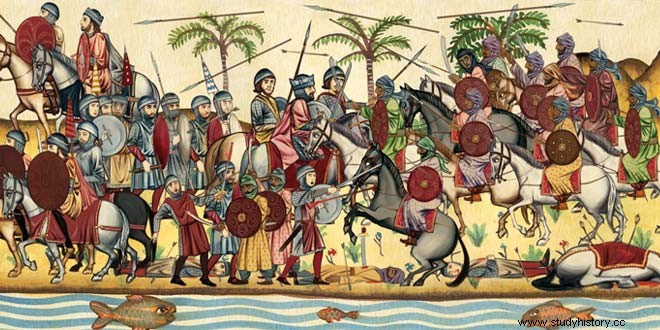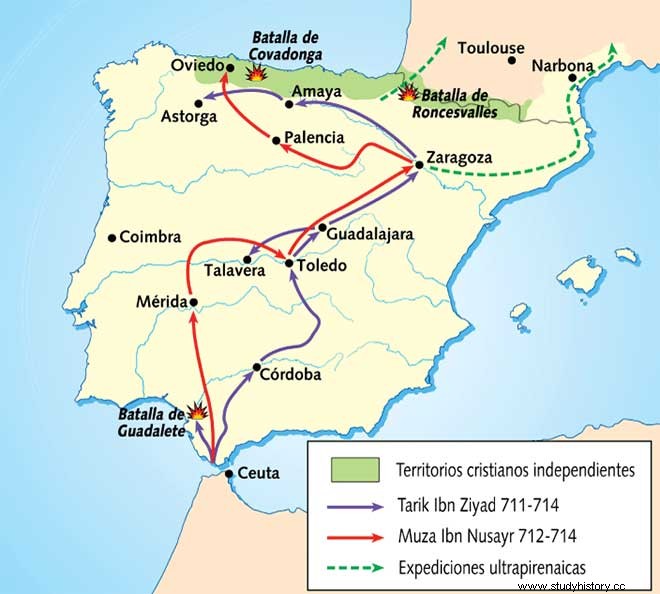The Muslim conquest began on July 19, 711, when on the banks of the Guadalete, the Arab and Berber troops of Táriq, freedman of Muza, defeated the Visigothic army of King Rodrigo , victim of the treacherous betrayal of Vitiza's children and those close to him, among whom the Archbishop of Seville, Oppas, stood out. Between this date and that of Covadonga, in 722, eleven years pass, perhaps the darkest in the history of Spain. In that long decade, what classical Spanish historiography calls the loss of Spain is consummated, rightly so, but in those years resistance and reaction are also brewing, which will explode in the mountains of Asturias. Covadonga is a natal and stellar moment for the history of Spain; the historian Claudio Sánchez Albornoz, who reconstructed the facts on the ground and from within the Christian archives and the Arab chronicles, without appeal. He then specified his research in his work The kingdom of Asturias with the subtitle Origins of the Spanish nation .
Toledo taken by the Caliphate of Damascus
The body of the defeated king was not found on the Guadalete battlefield. They run, since then, strange legends about the final destination of him; but it seems that the fideles of him They took him to his final rest in Viseu, in present-day Portugal. He has also spread the species that the Goths were able to give a later battle near the Peña de Francia, in the fields of Salamanca, next to the town of Segoyuela; but Sánchez Albornoz refutes this hypothesis, although he admits a second, and definitive defeat, of the Visigoths against the Islamists in Ecija, where the betrayal of Guadalete was no longer repeated and the invaders suffered great mortality as a result. After his victory at Ecija, Táriq advanced to the capital of the kingdom, Toledo, where he disappointed the vitizens, who were expecting the enthronement of one of their own. Táriq, who conquered Toledo with the efficient cooperation of the Jews, despised the traitors and assumed the kingdom of Spain in the name of the Caliph of Damascus. It was the day of San Martin, November 11, 711, the date that marks the loss of Spain.

Muslim Advance in the Kingdom of Spain
At the head of a wing of the army, which displayed a strategic sense and amazing tactical efficiency in its rapid conquest of the Peninsula, Mugait-al-Rumí occupied the city of Córdoba, over which the invaders would soon demonstrate their preferences by choosing it as their capital. . Throughout Visigothic Spain, with the exception of some heroic cities, where the Hispano-Romans predominated, the cry was given to save yourself if you can. The nobles of the kingdom of Toledo fled north with what treasures they could; one of them was found in Guarrazar, with the crowns of some kings. The fled crossed the Guadarrama, via Buitrago, and took refuge in the almost inaccessible rock of Amaya, in the confines of the Cantabrians; but Táriq charged his new Jewish allies with the defense of the capital and pursued him to the fortress of Amaya, which he easily overran. Nothing seemed to resist the Muslim impulse in Spain. Táriq also dominated the city of Astorga and returned to Toledo when his boss, Muza, jealous of his freedman's victory, had landed in Spain with a strong military contingent, which can be calculated approximately between ten thousand and eighteen thousand men. .
Treason of the Goths and Jews
The loss of Spain is explained, according to Sánchez Albornoz, by the chronic discord between the Hispano-Visigoths, as we have already explained, and by the betrayal of two forces that we would call fifth columns , with the terminology of the last Spanish civil war:the Goths in favor of the vitizens and the Jews. Anxious to preserve their situation with the new rulers, the former did not hesitate to resort to open betrayal when they deemed it convenient; for example, the occasion in which they presented themselves before Carmona as refugees and opened the doors of the plaza to the Arabs at night. Among all the Vitiza traitors, as we have said, the Archbishop of Seville, Oppas, Vitiza's brother and main informer of his co-religionists before the new power, who used him as an emissary to intimidate the Christian nuclei of resistance, stood out. We will see him in Covadonga, fulfilling this function. As for the Jews, they took revenge with such behavior for the prolonged, and often unjust, persecution to which the Visigoth kings and councils had subjected them . In the Christian Spanish people, this betrayal of the Jews of Spain remained very vivid, although contusive, which would later encourage, throughout the Middle Ages, as one of the main roots of hatred against the children of Israel in the reconquered Spain. We can assure you that the help of the Jews of Toledo and Granada was decisive for the overwhelming success of the Islamic campaigns in Spain.

Muza's Advance and Conquests
Upon arrival in the Peninsula. Muza decided for himself and his sons to seize the important places that had been surpassed by Táriq's advance on Toledo and later on Amaya and Astorga. The Muslim campaign for domination lasted approximately a year after Muza's arrival. Mérida and Seville, whose main population center was Hispanic-Roman, resisted long sieges, which removes the suspicion of lack of courage for the ancient Romans of Hispania; Niebla and Beja effectively collaborated with the Sevillian resistance. But Muza's son, Abd-al-Aziz, subjugated almost all of these cities upon his return from a victorious campaign through southeastern lands, where he concluded an autonomy pact with the Gothic nobleman Teodomiro, who established a vassal kingdom between Orihuela and Caravaca. Muza was personally in charge of the surrender of Mérida, on June 13, 715, due to the importance that the city had in Spain as a whole.
Covenant System
The system of pacts conceived by the invaders, in which certain rights were guaranteed to the vanquished, contributed to softening the defeats and undermining the spirit of resistance. They were, according to Sánchez Albornoz, of two kinds:the type ahd —like the one agreed upon with Teodomiro in the lands of Murcia—was equivalent to considerable political autonomy; the one of type suhl , granted to Mérida, imposed respect for lives and property, although it confiscated the properties of the Church and those of those who fled to the north.
Resistance of the Spanish peoples
Conquered the old Emérita, Muza left for Toledo and Táriq came to meet him in Almaraz. The interview was stormy and Muza assumed command, although he confirmed the conquest of Spain for the caliph of Damascus. The Arabs continued with various marches the submission of the Hispanic soil, for which they used the pact or terror, as in the campaign over the Ebro valley, where the two leaders again divided forces. Muza was marching up the Ebro when a Visigothic nobleman, Count Casius, submitted to him, whose descendants, the Banu-Qasí, would play a major role in the next stage of Aragon and Navarre. Offering hardly any resistance, the Basque barbarians, who had been largely responsible for the loss of Spain due to their ill-timed resistance to Rodrigo, complied with the new invading power and suffered from its abuses. Muza penetrated the indomitable lands of the Várdulos, the Cantabri and the Asturians, and imposed, like Táriq in the Tarraconense, their domination by terror. The morale of the Visigoths, whose armies had been defeated so easily, and of the Hispano-Romans, seeing that the warrior caste that had dominated and ruled them yielded so abjectly, erased, between pacts and terror, all resistance. Muza sent detachments to the north coast, won with much greater effort by Octavian Caesar Augustus himself; he crossed the ports of Galicial and seized Lugo. There he was found by an envoy from the caliph of Damascus, who without further ado took his mule by the halter and took him to the presence of his distant lord.
Nothing in Spain seemed to resist the fury of the invaders, who soon decided to conquer Gaul. Some high Pyrenean valleys remained untrodden, and the Muslims did not establish themselves at the moment in points of Cantabria, Álava and Vizcaya, although their Berber garrisons controlled, from various strongholds, the entire Asturian territory, practically all of Galicia.
